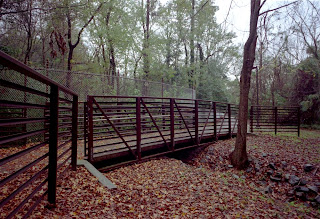I received a package today that included 10 sheets of 4x5. These are a variety of shots from many locations from the last few months. I shoot color film sparingly, and transparencies even less due to the high cost and necessity of sending it out. Getting a batch back from California (I use North Coast Photographic) is always like Christmas morning!
Here are a selection of images from this batch of film with some technical info. All images were shot with Velvia 50 or 100 film. For most things I find these films interchangeable, but Velvia 50 does have a little more "oomph," for lack of a real definable quality. This film has the most intense and saturated color of all transparency film. It is loved by landscape photographers for good reason - and many think it is the best color film ever made.
First up is two images from my
return to Spook Bridge. Any landscape photographer worth their salt knows what the "golden hour" is - that mystical 30 minutes before and after a sunset or sunrise. Even more important is the occasional 15 minutes or so of absolutely perfect warm sunlight right after sunrise or right before sunset. I was lucky enough to have my view camera ready and some Velvia for the spectacular light that lasted just a few short minutes. here is the result: a painterly view off the bridge with the Withlacoochee River in the background. Shot with a Nikon 90mm f/8 lens:
I also took an image looking into the forest from on the bridge identical to the black & white version earlier. Again with the Nikon 90mm:
Moving on, here are a couple images that you may recognize from earlier posts in b&w. Here are the color versions. First image was with a Schneider 150mm APO lens, second is the Nikon 90mm again:
Here are two images now from Banks Lake. These were made right as the sun was rising, but the wonderful warm light was absent. The intense blue is still very nice, especially with the reflection on the water. First image is with a Schneider 210mm Symmar-S lens, second is with a Schneider 47mm XL f/5.6 lens (equivalent to a 13mm on 35mm!!):
Finally, here is an image from St. George Island in Florida. This is the lighthouse that greets you as you come onto the island. The dizzying perspective was made possible with a Schneider 58mm XL lens:
I really love Velvia and these images really shine from the intense colors from this film. I only wish it wasn't so expensive! Film cost + processing adds up to about $5 per sheet. This is obviously why I shoot it sparingly!




















































